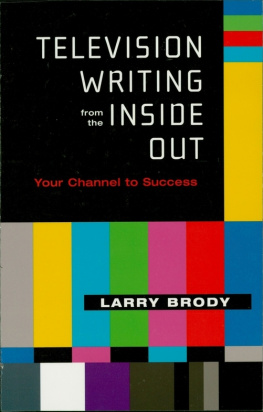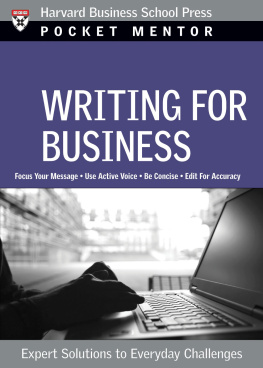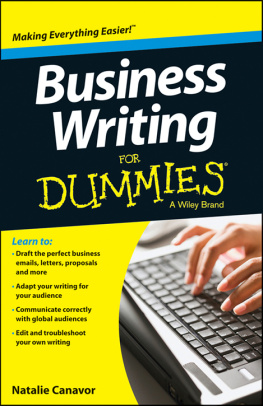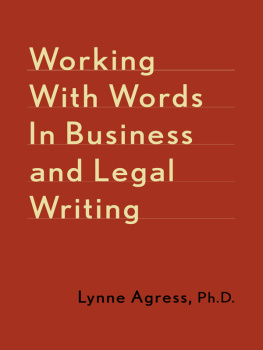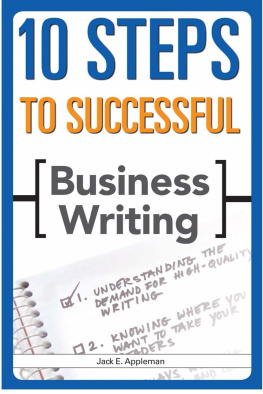Jon Ramsey - Business Writing Scenarios: Writing from the Inside
Here you can read online Jon Ramsey - Business Writing Scenarios: Writing from the Inside full text of the book (entire story) in english for free. Download pdf and epub, get meaning, cover and reviews about this ebook. year: 2017, publisher: Macmillan Higher Education, genre: Home and family. Description of the work, (preface) as well as reviews are available. Best literature library LitArk.com created for fans of good reading and offers a wide selection of genres:
Romance novel
Science fiction
Adventure
Detective
Science
History
Home and family
Prose
Art
Politics
Computer
Non-fiction
Religion
Business
Children
Humor
Choose a favorite category and find really read worthwhile books. Enjoy immersion in the world of imagination, feel the emotions of the characters or learn something new for yourself, make an fascinating discovery.
- Book:Business Writing Scenarios: Writing from the Inside
- Author:
- Publisher:Macmillan Higher Education
- Genre:
- Year:2017
- Rating:3 / 5
- Favourites:Add to favourites
- Your mark:
- 60
- 1
- 2
- 3
- 4
- 5
Business Writing Scenarios: Writing from the Inside: summary, description and annotation
We offer to read an annotation, description, summary or preface (depends on what the author of the book "Business Writing Scenarios: Writing from the Inside" wrote himself). If you haven't found the necessary information about the book — write in the comments, we will try to find it.
Jon Ramsey: author's other books
Who wrote Business Writing Scenarios: Writing from the Inside? Find out the surname, the name of the author of the book and a list of all author's works by series.
Business Writing Scenarios: Writing from the Inside — read online for free the complete book (whole text) full work
Below is the text of the book, divided by pages. System saving the place of the last page read, allows you to conveniently read the book "Business Writing Scenarios: Writing from the Inside" online for free, without having to search again every time where you left off. Put a bookmark, and you can go to the page where you finished reading at any time.
Font size:
Interval:
Bookmark:
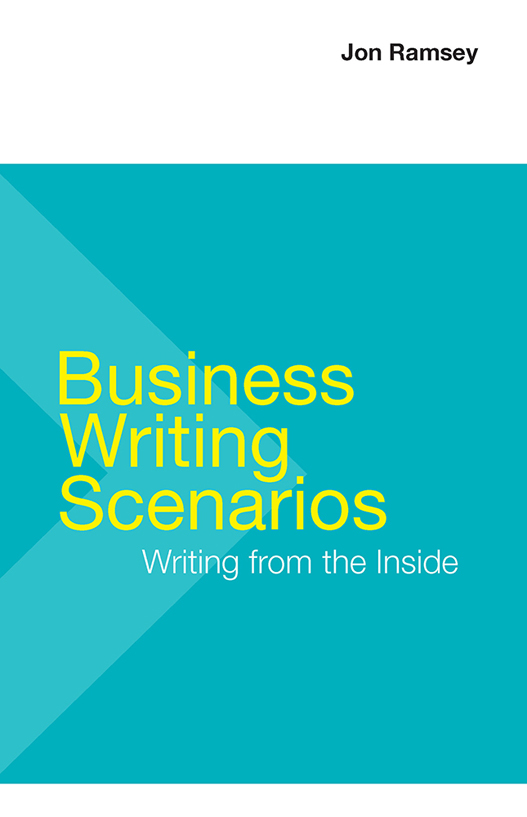
Writing from the Inside
Writing from the Inside
Jon Ramsey

For Bedford/St. Martins
Vice President, Editorial, Macmillan Higher Education Humanities: Edwin Hill
Editorial Director, English and Music: Karen S. Henry
Senior Publisher for Composition and Business and Technical Writing: Leasa Burton
Executive Editor: Molly Parke
Developmental Editor: Beth Castrodale
Associate Editor: Rachel C. Childs
Editorial Assistant: Evelyn Denham
Production Editor: Lidia MacDonald-Carr
Assistant Production Supervisor: Victoria Anzalone
Associate Marketing Manager: Sophia La Torre-Zengierski
Project Management: Books By Design, Inc.
Director of Rights and Permissions: Hilary Newman
Senior Art Director: Anna Palchik
Text Design: Books By Design, Inc.
Cover Design: William Boardman
Composition: Books By Design, Inc.
Copyright 2016 by Bedford/St. Martins.
All rights reserved. No part of this book may be reproduced, stored in a retrieval system, or transmitted in any form or by any means, electronic, mechanical, photocopying, recording, or otherwise, except as may be expressly permitted by the applicable copyright statutes or in writing by the Publisher.
109876
fedcba
For information, write: Bedford/St. Martins, 75 Arlington Street, Boston, MA 02116 (617-399-4000)
ISBN: 978-1-3191-1716-0 (EPUB)
Acknowledgments and copyrights appear on the same page as the text and art selections they cover; these acknowledgments and copyrights constitute an extension of the copyright page. It is a violation of the law to reproduce these selections by any means whatsoever without the written permission of the copyright holder.
- To become an effective business writer and colleague, you need to imagine your way inside a wide variety of business situations. This chapter explores the fundamentals of this approach.
- Before you begin composing any piece of business writing, you will need to consider your role and authority within the business organization, your purpose in writing, the audience you must reach, the strategy that is most likely to achieve the desired goal, and the best medium for your communication purposes. This chapter examines these important factors.
- Knowing how to draft an effective rsum and cover letter is key to your success in securing a position and advancing in your field. This chapter gives practical advice on creating these important documentsand on succeeding in the job search.
- As a business writer you want to create documents that are as aesthetically pleasing as they are easy to read and understand. This chapter covers design basics, as well as important document formats and conventions.
- It is important to address colleagues as valued partners in a shared enterprise. This style of communication will help foster a culture of cooperation, productivity, and respect that is crucial to any organizations success.
- External audiences with whom you communicate will view you as a representative of your organization, so it is important to make a good impression on them. This chapter will help you communicate effectively with such audiences, even under the most challenging circumstances.
- As you advance in your career, you may be called on to develop longer, more complicated documents, such as grant proposals or business plans. This chapter will introduce you to the fundamentals of these more complex pieces of writing.
- Even highly experienced business professionals make communication errors at times, and you can learn from their mistakes. This chapter provides examples of some especially glaring gaffes to avoid.
- In this chapter, well take a closer look at leadership qualities that you can foster in yourself to become both a better communicator and a better colleague.
Human beings organize themselves into complex social, cultural, political, and business units. Effective communication practices are essential for sustaining these social, civic, and professional structures and for advancing their interests. At its heart, Business Writing Scenarios: Writing from the Inside is about business communications in this broader sense. The book centers on the human relationships facilitated or negotiated through written (and other) communications, which can help businesses thrive over time or, in other instances, leave them in a weakened state. Business Writing Scenarios also examines the value systems, thinking patterns, and communication strategies that are the hallmarks of successful leadership across a variety of organizational structures.
Central to this book are the scenarios of its name: real-world business situations that students are likely to encounter as they pursue their careers. The scenarios immerse students in challenging writing situations for example, having to convey disappointing news, to explain a major policy change, or to respond to a difficult customer and show how writers addressed these situations effectively or ineffectively. After analyzing the scenarios, students apply what theyve learned through activities (applications) that ask them to respond in writing to similar business situations. The applications provide advice on how to address the particular challenges of each writing situation, helping students focus on their purpose and audience and on the most productive communication strategies. As they analyze the scenarios and complete the applications, students build the thinking and writing skills that will serve them for years to come in any professional situation.
Business Writing Scenarios also helps students avoid writing gaffes, which can have serious consequences and which, thanks to the rise of digital communications, have never been easier for others to discover and disseminate.
Throughout the book, students will learn to communicate clearly and without wasting words and, thus, their audiences time. They will also learn to develop nuances of tone, learn how to marshal sufficient evidence, and learn how to understand audience psychology in other words, to assess what will achieve a particular purpose based on audience needs and expectations. All of these skills are essential in complex business writing situations. This approach to business writing, and the focus of this book, asks students to imagine their way into business and leadership roles that most of them have not yet experienced and to think creatively and strategically as they write their way toward persuasive communications.
Bedford/St. Martins offers resources and format choices that help you and your students get even more out of your book and course. To learn more about or to order any of the following products, contact your Bedford/St. Martins sales representative, e-mail sales support (sales_support@bfwpub.com), or visit the Web site at macmillanhighered.com/businesswritingscenarios/catalog
Font size:
Interval:
Bookmark:
Similar books «Business Writing Scenarios: Writing from the Inside»
Look at similar books to Business Writing Scenarios: Writing from the Inside. We have selected literature similar in name and meaning in the hope of providing readers with more options to find new, interesting, not yet read works.
Discussion, reviews of the book Business Writing Scenarios: Writing from the Inside and just readers' own opinions. Leave your comments, write what you think about the work, its meaning or the main characters. Specify what exactly you liked and what you didn't like, and why you think so.




